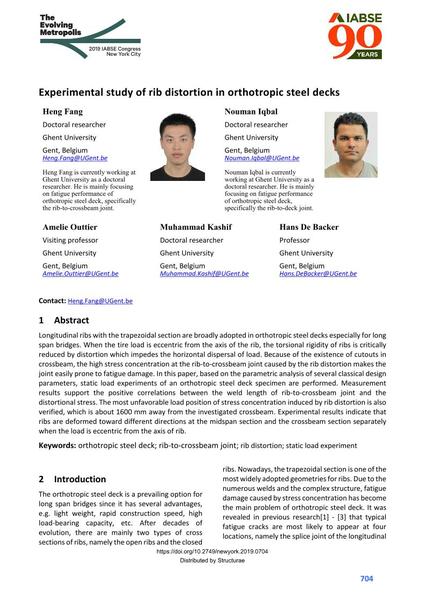Experimental study of rib distortion in orthotropic steel decks

|
|
|||||||||||
Bibliographic Details
| Author(s): |
Heng Fang
Nouman Iqbal (Ghent University) Amelie Outtier (Ghent University) Muhammad Kashif (Ghent University) Hans De Backer |
||||
|---|---|---|---|---|---|
| Medium: | conference paper | ||||
| Language(s): | English | ||||
| Conference: | IABSE Congress: The Evolving Metropolis, New York, NY, USA, 4-6 September 2019 | ||||
| Published in: | The Evolving Metropolis | ||||
|
|||||
| Page(s): | 704-710 | ||||
| Total no. of pages: | 7 | ||||
| DOI: | 10.2749/newyork.2019.0704 | ||||
| Abstract: |
Longitudinal ribs with the trapezoidal section are broadly adopted in orthotropic steel decks especially for long span bridges. When the tire load is eccentric from the axis of the rib, the torsional rigidity of ribs is critically reduced by distortion which impedes the horizontal dispersal of load. Because of the existence of cutouts in crossbeam, the high stress concentration at the rib-to-crossbeam joint caused by the rib distortion makes the joint easily prone to fatigue damage. In this paper, based on the parametric analysis of several classical design parameters, static load experiments of an orthotropic steel deck specimen are performed. Measurement results support the positive correlations between the weld length of rib-to-crossbeam joint and the distortional stress. The most unfavorable load position of stress concentration induced by rib distortion is also verified, which is about 1600 mm away from the investigated crossbeam. Experimental results indicate that ribs are deformed toward different directions at the midspan section and the crossbeam section separately when the load is eccentric from the axis of rib. |
||||
| Keywords: |
orthotropic steel deck rib-to-crossbeam joint rib distortion static load experiment
|
||||
